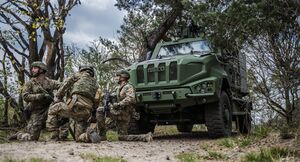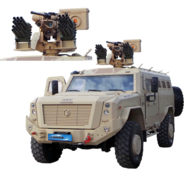MILCAR Culebra VTM
| MILCAR Culebra VTM | |
|---|---|
 Pelaxian Culebra armed with a Protector remote weapon station | |
| Type | Armoured personnel carrier |
| Place of origin | |
| Service history | |
| In service | 2033–present |
| Used by | See Operators below |
| Production history | |
| Designer | MILCAR |
| Specifications | |
| Mass | ± 12,800 kg (kerb) |
| Width | 2,430 mm |
| Height | 2,800 mm |
| Crew | Soft-Top and Hard-Top versions can accommodate a team of 2+2, the Pick-up a crew of 2 and the Medevac transport a crew of 2+2 lying or 2+4 sitting casualties, while the Military Police / Security Vehicle can accommodate a crew of 2+6 and can be configured as an assault ladder. |
Main armament | Protector remote weapon station • Manned open turret up to 12.7mm HMG or 40mm AGL • Flecha ATGM |
| Engine | NEF67 EUIII 6.7L six-cylinder diesel, turbocharged 276 hp (207 kW) |
| Power/weight | 23 hp/tonne |
| Suspension | 4×4 wheeled independent hydropneumatic suspension |
Operational range | 600 km (370–530 mi) |
| Maximum speed | 90 km/h (limited) |
The MILCAR Culebra VTM (Vehículo Táctico Medio), military designation "Culebra" for the Milk Snake native to Pelaxia, is an infantry mobility vehicle and medium MRAP designed and manufactered by MILCAR Defence Vehicles for the Pelaxian Armed Forces. The acquisition is part of the Joint Replacement Programme of Wheeled Vehicles of the Pelaxian Ministry of Defence, with deliveries planned from 2033 until 2036. In Pelaxian service, the Culebra will replace the ageing fleet of MILCAR Jararaca's and MILCAR Urutu's of the Pelaxian Army, Pelaxian Marine Corps and Pelaxian Air Force.
Deliveries are planned for the second half of 2033 and should be completed by 2036.
Being the launching customer for the Culebra besides the Pelaxian Armed Forces, the vehicle was developed in close cooperation with the (KISTAN COMPANY OR MILITARY DEVELOPMENT) and adjusted to the requirements of the (KISTAN MILITAY/BRANCH). The Culebra is being procured with the aim to provide troops with improved protection and payload capacity, as well as for modularity purposes. The vehicle can be equipped with a range of add-ons, including remote weapon stations, armour packages, jammers and CBRN defence equipment, among others.
The Culebra's classification as a medium Mine-Resistant Ambush Protected (MRAP) vehicle exemplifies its balanced design, combining protective capabilities with agility. This distinction places the Culebra within the versatile mid-range of MRAP vehicles, making it an optimal choice for a wide array of missions and terrains. Unlike heavier MRAPs, the Culebra excels in off road operations, where its adaptable nature is a distinct advantage, offering a vital balance between protection, maneuverability, and transport capacity.
Development

In the wake of the Akanatoa War, the Pelaxian military embarked on a transformative journey in infantry doctrine. The harsh lessons learned during this conflict underscored the need to adapt to the realities of urban warfare and asymmetric combat in an ever-changing modern world. As a result, the focus shifted toward providing greater protection and flexibility for the infantry, fundamentally reshaping the way Pelaxian forces operate in overseas operations.
One crucial aspect of this new doctrine was the compromise between amphibious mobility and safeguarding infantry units. Recognizing that urban warfare often unfolded in densely populated areas, it became evident that the safety of the infantry was paramount. In response, the Pelaxian military made deliberate choices to provide enhanced protection for its soldiers, even at the expense of some amphibious capabilities. This approach ensured that the infantry was better equipped to deal with the unpredictable and hazardous conditions of urban and asymmetric warfare.
Another fundamental shift was the decision to replace every light armored tracked vehicle with wheeled vehicles. This transition was made for several compelling reasons. First, wheeled vehicles were considerably easier to maintain, reducing downtime and increasing operational readiness. Second, wheeled vehicles were more adaptable to rapid deployment, allowing for swift movement both by sea and air. This change in the vehicle fleet was integral to the new infantry doctrine, enhancing Pelaxia's capacity to respond to evolving security challenges.
In sum, the Akanatoa War marked a turning point for the Pelaxian military, driving a shift in infantry doctrine towards greater protection for soldiers in urban and asymmetric combat scenarios. The integration of wheeled vehicles in place of light armored tracked vehicles was emblematic of this transformation, prioritizing adaptability and maintenance to ensure readiness and efficiency in an ever-changing landscape of conflict.
Procurement
To modernize the aging fleet of wheeled vehicles within the armed forces, the Pelaxian Ministry of Defense launched the Renewal of Operational Wheeled Vehicles (ROV) program. The Culebra, purposefully designed for high-intensity urban combat, has been selected for the 12 kN category, indicating its capability to carry payloads of around 1,200 kilograms. The Culebra is set to fulfill a variety of roles and replace several outdated vehicles, including variations of the MILCAR Urutu and MILCAR Jararaca.
On December, 2032, the Minister of Defense announced that the Ministry of Defense had chosen Pelaxia's own Culebra light tactical vehicles to enhance the capabilities of the Pelaxian Armed Forces. This comprehensive project also encompasses the supply of remote-controlled weapon stations (RCWS) that can be seamlessly integrated into these vehicles. The contract includes the development and provision of:
- 1000 Culebras and 500 RCWS.
- 300 Culebras Security variant.
- 600 Culebras and 100 ATGMs stations can be ordered through an option included in the contract, which would ultimately bring the total to 1,900 Culebras.
Additional Culebras can be ordered within five years after the delivery of the final vehicle.
Technical Specifications

In the pursuit of increased protection and adaptability for the infantry, the military sought to equip its forces with vehicles capable of excelling in urban warfare and asymmetric combat scenarios. The resulting choice was the Culebra, a versatile wheeled vehicle designed to meet the challenges of modern conflict.
Engineered with precision and purpose, the Culebra is powered by an EF67 EUIII 6.7L six-cylinder turbo-diesel engine. This formidable powerplant generates 267 HP (207 kW) and an impressive 1000 Nm of torque, ensuring that the vehicle is well-equipped to tackle the rigors of demanding combat environments. Notably, the engine has been fully militarized, capable of running on military-grade fuel, underscoring its resilience and adaptability in the field.
In terms of mobility and endurance, the Culebra boasts a maximum range of 600 kilometers. Its standard fording depth reaches 750 mm, while the Pelaxian Marine Corps variants exhibit an even more impressive fording depth of 1500 mm. These specifications emphasize the Culebra's capacity to traverse a variety of terrains, making it well-suited for the diverse challenges presented by both urban environments and off-road scenarios.
Maintaining a balance between mobility and control, the Culebra features a ladder frame, leaf springs, and anti-roll bars to navigate the unpredictability of urban warfare. It is equipped with permanent four-wheel drive and three locking differentials, enabling it to conquer challenging landscapes. To enhance control and stability, the Culebra's disc brakes are paired with an anti-lock braking system, a crucial feature for ensuring the safety of the infantry it transports.
Furthermore, the Culebra includes a central tire inflation system that permits the adjustment of tire pressure for its tires. This capability is managed from within the cabin, enabling the vehicle to adapt swiftly to changing conditions on the battlefield. The synergy of these technical specifications makes the Culebra a remarkable addition to the Pelaxian military's capabilities, embodying the lessons learned during the Akanatoa War and the pursuit of a modern infantry doctrine focused on protection, readiness, and adaptability.
Structure and Variants
The Culebra presents a remarkable diversity of variants, each meticulously engineered to fulfill specific roles within the Pelaxian Armed Forces. All Culebra models are constructed with bodywork composed of armoured steel, exhibiting an exceptional degree of Brinell hardness. This robust foundation ensures that the vehicle can be adapted to various combat scenarios, reflecting its versatility.
The Culebra's adaptability shines in its hardtop, softtop, and utility variants. These models can be swiftly upgraded with add-on armor packages, providing both ballistic and mine protection. The beauty of this approach lies in its modular design; these vehicles are "fitted for, but not with" protection kits. In practical terms, this means that protection kits can be conveniently installed or removed from the vehicles directly in the field, utilizing basic tools. This adaptable feature significantly reduces wear and tear, along with associated lifecycle costs, allowing the Culebra to maintain optimal performance throughout its service life.
For certain critical roles, such as casualty transport, military police, and air force security, the Culebra is equipped with standard armor kits, ensuring the safety and protection of personnel. This robust design underlines the vehicle's commitment to the well-being of its occupants and its effectiveness in combat situations.
Beyond its inherent armor capabilities, the Culebra can be outfitted with a range of advanced systems to bolster its operational effectiveness. These include CBRN (Chemical, Biological, Radiological, and Nuclear) defense systems, enabling the vehicle to operate safely in a variety of hazardous environments. To facilitate superior command and control, C4I (Command, Control, Communications, Computers, and Intelligence) systems can be integrated, enhancing communication and coordination capabilities.
In the realm of electronic warfare, the Culebra can be equipped with jammers, enabling the disruption of enemy communication and tracking systems, thus providing a crucial tactical advantage. To further augment its defense capabilities, the vehicle can be outfitted with Rheinmetall ROSY smoke grenade launchers, which create effective smokescreens to obscure the vehicle and its troops from potential threats.
- Hardtop
- Softtop
- Pick-up
- Casualty Transport
- Military Police/Security
Armament
Operators


National Gendarmerie of Burgundie: 50 hardtop variants ordered by the National Gendarmerie to be deployed in Equatorial Ostiecia with an unmanned turret with a 12x2 40mm non-lethal Lansing-Mitchell IronFist Vehicle Mount Launching System in tandem with a 7.62 machine gun
- 1000 Culebras ordered in hard-top variant with 500 on basic configuration armed with 12.7mm manned turrets, and 500 with 7.62mm RCWS.
- 300 Culebras ordered in Security variant.
- 600 Culebras ordered in soft-top variants with a 100 armed with ATGMs stations.